
Lioness feeding. Photo by: Cyril Christo and Marie Wilkinson.
In the new book, In Predatory Light: Lions and Tigers and Polar Bears, authors Elizabeth Marshall Thomas, Sy Montgomery, and John Houston, and photographers Cyril Christo and Marie Wilkinson share with us an impassioned and detailed appeal to appreciate three of the world’s biggest predators: lions, tigers, and polar bears. Through lengthy discussions, combining themes from scientific conservation to local community folklore, In Predatory Light takes us step by step deeper into the wild world of these awe-inspiring carnivores and their varied plight as they facedown extinction.
The book’s authors showcase the fragility, power, and grace of these mammals, allowing the reader to feel close to them. Their stories push us to comprehend the intelligence of these top predators and glimpse their own understanding of their raw lives on Earth. Reading In Predatory Light makes one believe that one can feel the ground, ice, and water in the same manner as lions, tigers, and polar bears. Meanwhile, Christo and Wilkinson’s photographs capture the textures, sounds, and experiences of the daily lives of lions, tigers, and polar bears.
A moving and engaging photo book, In Predatory Light takes us into their worlds where the five senses plus intuition, rudimentary intelligence, and wisdom dominate.
Mongabay.com recently interviewed the book’s award-winning photographers, Cyril Christo and Marie Wilkinson, about their experiences with some of the world’s most awesome predators and what it would mean for the human species if we allowed these other predators to vanish altogether.
INTERVIEW WITH CYRIL CHRISTO AND MARIE WILKINSON

Tiger. Photo by: Cyril Christo and Marie Wilkinson.
Mongabay: How do you use your photographs to communicate the threat of extinction of these apex predators to children?
Cyril Christo and Marie Wilkinson: We intended to make a manifesto with In Predatory Light and not merely a photographic wildlife book. Too often people are seduced by photos and forget the larger message. The essays, the quotations, look at the larger context of the animals from the indigenous and Western point of view so that the experience of the book is not just a visual one but also a meditation, a testament, a mindful and poetic plea to the beings at stake. We like to have a combination of environmental panoramas with specific shots to remind the audience of the larger story. Like this image of icebergs in the Davis Strait between Greenland and Baffin Island, icebergs that appear to be levitating due to the effect of what is called Fata Morgana; they are icebergs that are melting due to climate change and challenging the future of the ice bear. One of the icebergs from the Davis Strait may have sunk the Titanic a century ago. It is the loss of the ice at the top of the world that may cause our civilization to become a global Titanic.
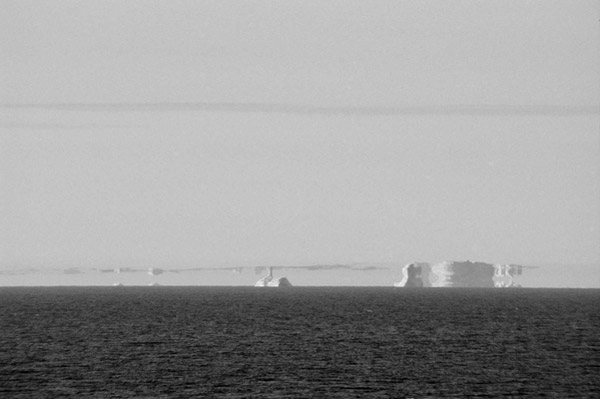
Davis Strait. Photo by: Cyril Christo and Marie Wilkinson.
Mongabay: What are you favorite stories, sounds, and images you use to share with others to transform them into understanding the need to protect lions, tigers, and polar bears?
Cyril Christo and Marie Wilkinson: One of the most remarkable stories we have ever heard is from a former elephant hunter, Koni, in southern Kenya who tells of his grandfather’s experience with a lion two generations ago. This hunter of the Tise family had not hunted in over a week. One night, he was by the bonfire ready to go to sleep when he heard a strange roaring in the distance, something in the lion’s voice was off but he couldn’t make out what it was. He went to sleep and was woken by a lion breathing down on him. The lion presented his paw to Koni’s grandfather with an acacia thorn paw in it, a thorn that had been causing him excruciating pain and that was preventing him from hunting. The hunter gingerly took out his knife and removed the thorn! The lion went back into the bush without incident. A few days later he saw what seemed to be the same lion. The lion looked at the hunter and started walking into the bush, stopped and looked over his shoulder to make eye contact with Koni’s grandfather so the hunter would follow him and continued into the bush. This happened several times until the hunter was lured to a meadow, where there in the open, lay a newly killed untouched giraffe that the lion had taken out as a gift to Koni’s grandfather for having saved his life! A story of Biblical proportions. Just like Androcles and the lion.
This story illustrates the cooperation that used to exist on some level between humans and lions. Lions may be killers but they are not ruthless. We are the only wanton killers on earth. Elizabeth Marshall Thomas illustrates this best when she lived with the Bushmen of northwest Botswana over sixty years ago. The lions would drink from the waterhole at night while the Bushmen drank during the day. There was no enmity between the two species, rather there was a truce!
The recent Guardian article January 9, 2014 “Rapid Loss of Top Predators ‘a major environmental threat'” illustrates the enormity of the issue. The article says “scientists warn that removal from ecosystem of large carnivores like the dingo could be as detrimental as climate change.” That is something the U.S. media does not cover. We need to put biodiversity at the heart of politics, the Guardian says. “Unless biodiversity loss goes on the agenda of every minister from transport to trade, our generation will fail the next one.” In our work we are fighting so we never have to tell the children of the future, this is where the wild things WERE!
Another superb story is from a Tswana tribesman, the people who arrived after the river Bushmen in the Okavango Delta in Botswana. Gee told us that he used to walk with his father in the bush and was told by his father to freeze if he ever came upon lion cubs. One day Gee and his father did come upon lion cubs and was told to stop! The mother lion came bounding out of nowhere towards Gee who maintained his ground. The lioness leaped in front of him, stopped a few feet from Gee, put her front paws on his chest, smelled him for a few seconds and returned to her cubs. Because he showed no fear, the lioness realized he was not an enemy and let him go. What we need to return to is a sense of a truce between ourselves and the rest of the natural world and its predators. If we become the last predator on earth and eliminate the last raptors and sharks, and cats and wolves on earth, it will not only become very lonely, and intolerable ecologically, we will self-cannibalize.
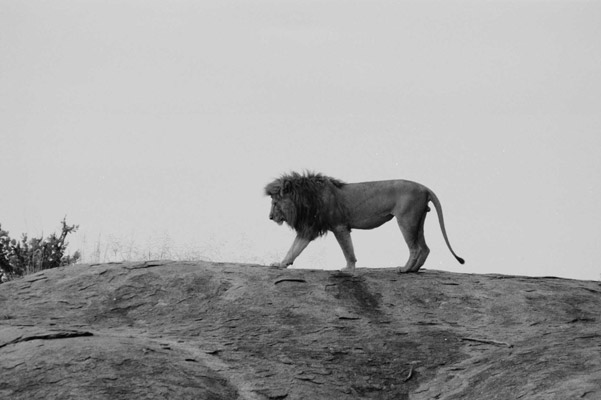
Male lion. Photo by: Cyril Christo and Marie Wilkinson.
Mongabay: What images—one from each animal: lions, tigers, and polar bears—are most striking to you? Images that draw our attention to something unknown and undiscovered within these animals?
Cyril Christo and Marie Wilkinson: One of my favorite lion shots is the white lioness from Timbavati, because it is a mystery. There are only a few hundred white lions on earth and this image resounds, unlike most wildlife images with an essential ambiguity…where did she come from…where is she going? It is out of focus, but the motion gives it its dynamism, its power and subtlety. So many photographs these days are color and so visually domineering there is no ambiguity left. The eye of the white lioness looks downwards almost off the frame. What is she looking at? The black background highlights her superb white fur and if she were coming from another time, another dimension, almost what one might call the place of origin. It is unique and not just a wildlife shot, but a portrait of essence.
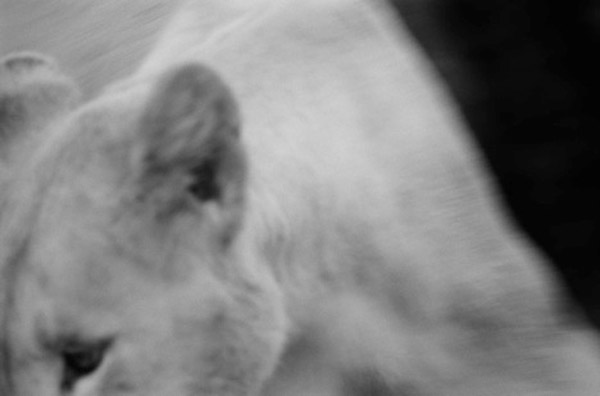
White lionness. Photo by: Cyril Christo and Marie Wilkinson.
The tigress crouching as if it were peering into the mind of the spectator…it is disarming…is it going to flee, or to pounce? She is calm yet eminently a deity full of power. She is the personification of a tiger, whose muscles and body truly resemble a flame, a live Bunsen burner like no other animal on earth. The tiger is eminently itself. It is honest as our guide told us. It does not ever take more than it needs unlike the human predator. But there is also a mystery to the tiger: its ability to disappear that renders it almost supernatural. One can easily understand on seeing one for the first time why it was made into a deity! I asked a priest in the village of Tala what would happen to us if tigers disappeared? He responded by saying it would not matter because we would not have humanity anymore. That is what is at stake. The intensity of this tiger’s stare reflects some of the ineffable fire Blake was trying to articulate in Tyger, Tyger Burning Bright. If India should lose her tigers (the greatest population on earth) she will lose her soul, because the last forests in India need the tiger. Already, due to climate change and the reduced monsoon, the forests are being challenged. The prey base is affected and that impacts the tiger!
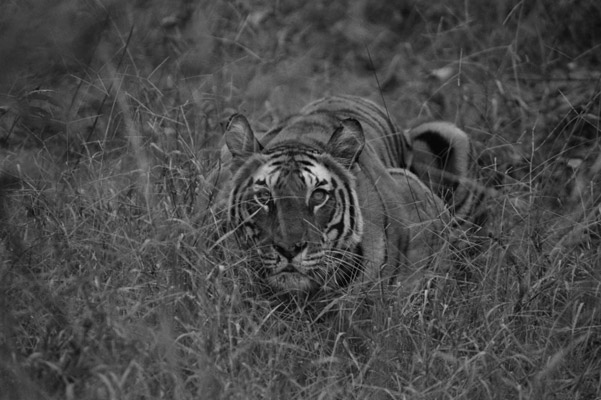
Tigress. Photo by: Cyril Christo and Marie Wilkinson.
The polar bear in Svalbard taken from the back. Its coat is drenched and it is struggling against the melting snow. The energy this extraordinary being is exerting to survive is enormous. Who among us could survive for months with barely anything to eat? The bear’s tracks are symbolic of the path of the Arctic ecosystem as a whole and the endangered cryosphere of the world. The future of the planet is being played out at the top of the world and so-called civilization still bickers about climate change!

Polar bear. Photo by: Cyril Christo and Marie Wilkinson.
Mongabay: What life experiences introduced you to seeking a deeper understanding of lions, tigers, and polar bears?
Cyril Christo and Marie Wilkinson: While one listens to tribal groups in East Africa and the Himba and Bushmen of southern Africa, is becomes apparent that the other beings are mirrors to our own identity. The Bushmen who told us stories of shamans able to ‘change’ into lions during the trance dance is captivating. In Africa the reality of the other is paramount. The lion is the top predator and everywhere there are reminders of its relationship to humans.
In the Arctic the Inuit shamans used to honor the polar bear. One almost longs to see one because of the vast horizon and infinities. It is an alter ego of sorts. To be seen by a polar bear reminds you instantly of your fragility, that you are simply a human and that there are other souls abiding on this earth. The Inuit hunted but also honored the polar bear. They say our civilization is burning the polar bears. The native people all over the world honor other beings, other animals. They have totems. We do not. We are preparing ourselves for the android future. We cannot simply dispense with millennia old traditions that honored the anima and hope to maintain the life force on earth.
On our first trip to Nepal we got a glimpse of a mother with a cub in Bardiya, western Nepal. It was like a vision. But how we got to see it was something akin to a miracle. Marie asked how we could see a tiger. Several people, including a computer expert from Kathmandu, had come seven times to Bardiya and had never seen a tiger. Marie made an offering of fruit to Bon Devi, the goddess of the forest, under a banyan tree and within an hour we saw a mother with cub pass right in front of us. There are connections between the human and non-human that we in the modern world have forgotten. The Mendriq people of Malaysia believe the tiger to be connection between thunderstorms and the underworld. Besides folklore and belief systems there is a matrix, an interspecies and supersensible bond that transcends science. I believe that part of our karma is being played out with these remarkable beings. Our place on this earth is being tested. We fail them, we will fail ourselves.
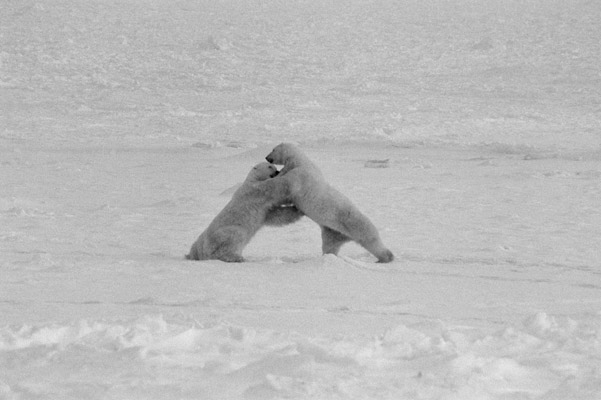
Polar bears. Photo by: Cyril Christo and Marie Wilkinson.
Mongabay: How do you hope to communicate through imagery both the vulnerability and the immediacy of the lives that lions, tigers, and polar bears live?
Cyril Christo and Marie Wilkinson: One or two photos cannot always relay the fragility of the situation…even in film it is often difficult. But through words and images the story can be conveyed more completely. We try to get a sense of the immediacy of the being in question, first close up, without a telephoto lens, then in the context of the horizon or the larger landscape or eco-system. This is a rare fogbow in Svalbard in Norway, like a portal opening to the kingdom of Thule beyond.
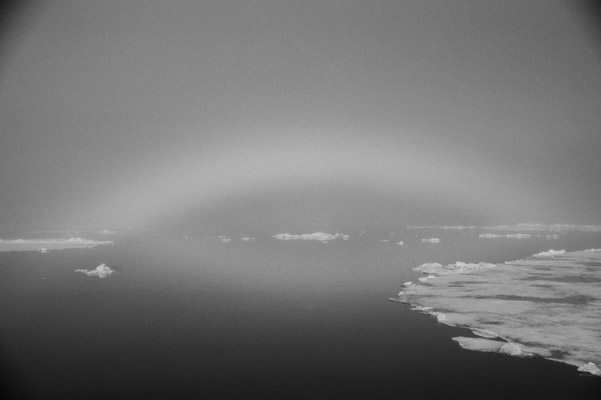
Fogbow in Svalbard. Photo by: Cyril Christo and Marie Wilkinson.
Mongabay: What are the key technological changes you have experienced in film and photography over the past 25 years that both make it easier and more difficult to capture the unique qualities of lions, tigers, and polar bears?
Cyril Christo and Marie Wilkinson: We always shoot traditional black and white photographs and as close as possible as often as possible. The main difference has been to interview and film native elders in the field and the fauna with compact digital video cameras. They are much easier to carry around but let us make sure we still have the organic world to be awed by in twenty years with all our technological obsessions and innovations. There are more cameras to choose from these days but fewer species! That is not a worthwhile tradeoff!
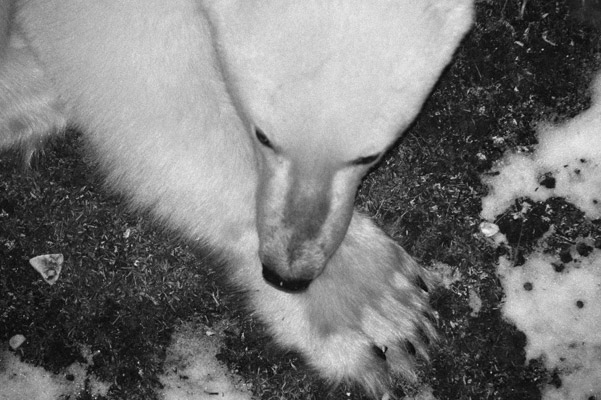
Polar bear. Photo by: Cyril Christo and Marie Wilkinson.
Mongabay: Which images from the book still stun and capture your imagination today, and why?
Cyril Christo and Marie Wilkinson: The lion and lioness side by side in Tarangire look like a frieze, out of time. They both look completely calm looking in the same direction, almost as if they were one being. Usually the male and female are either fighting or playing or lying down or separate. Here they resemble one mind contemplating the world. Very rare.
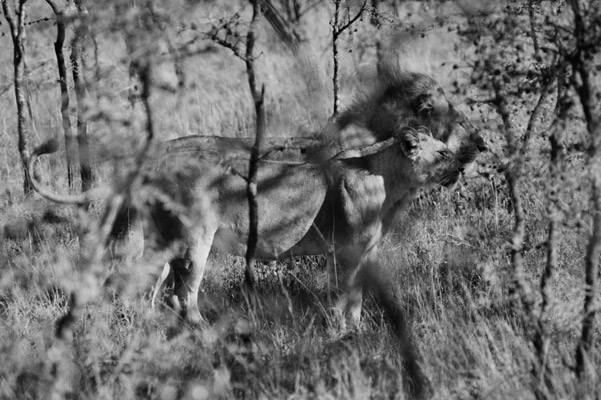
Lions side-by-side. Photo by: Cyril Christo and Marie Wilkinson.
This tiger, weighing 600 pounds is climbing the tree to sharpen its claws. This is also an event one does not often see… like a tiger kill. This tiger maneuvered through the foliage and skirted up the tree for a few brief seconds like a sylvan ballet dancer. Fantastic!

Tiger sharpening claws on a tree. Photo by: Cyril Christo and Marie Wilkinson.
The polar bear leaping like an odalisque over the ice floes in Svalbard. It is emblematic of the enormous struggles the polar bear faces. The bear seems to be moving effortlessly but it is thin and very much challenged by increasingly precarious ice floes.

Polar bear jumping ice floes. Photo by: Cyril Christo and Marie Wilkinson.
Mongabay: What is your day like when you are in the field?
Cyril Christo and Marie Wilkinson: To get up in Africa and to hear the morning doves welcoming you to Africa and its light is one of the great joys on earth. We get our bags together…make sure Lysander (our son) has snacks…and let the world unfold. We try to find places where we can walk and hear what the guides have to say because sometimes it is more interesting than anything one sees. Stories are the human foundation of Africa and the guides know more about the land than any conservation biologist, always! We look and listen and are amazed each and every time.
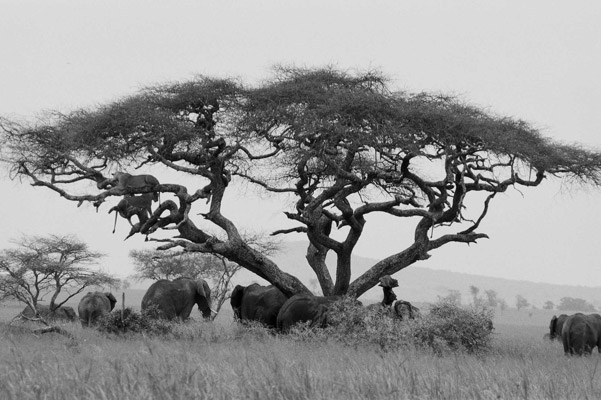
African scene: elephants and lions. Photo by: Cyril Christo and Marie Wilkinson.
Mongabay: Which populations of lions, tigers, and polar bears are you most connected to and why?
Cyril Christo and Marie Wilkinson:Lion rushing by in the Okavango 2010. Each time we see a being of any kind, there is a connection…like each child is different from all others. The first lions we saw in the Mara, right outside our camp, is something one never forgets. The lions roaring in the Okavango, especially the ones roaming at night is a primordial memory.

Lion in the Okavango Delta. Photo by: Cyril Christo and Marie Wilkinson.
Mongabay: How can the traditional knowledge and beliefs written about in In Predatory Light shed light and provide some ideas for how we can market lifestyle changes to avoid extinction of these amazing animals?
Cyril Christo and Marie Wilkinson: We need an immediate Marshall plan that activates an environmental consciousness about the biosphere. Governments, businesses, and individuals should launch campaigns in the street or TV specials and ask people to donate. Ecology courses should be required of every preschool, elementary, high school and university in the country. What do Americans know about the Dine (Navajo)? What botanical knowledge have we gained from the Surma of Ethiopia or the Maasai? The most basic relationship you can have is one of respect and awe. In our last book, Walking Thunder we encountered the Samburu whose relationship to the elephant is a clan relation, the elephant being the most important. They say there is a seed of a human being inside each elephant. They helped us survive. And how does the modern world respond. It mutilates it into toothpicks and ivory statuettes! The Samburu recount the times when there was drought. The elephants would help the Samburu find water and the Samburu would help give the elephants honey. They honored the elephant because their very survival depended on a larger scope than human-to-human relationship. It is a remarkable bond. What do we bond with? Our cell phones and computers.
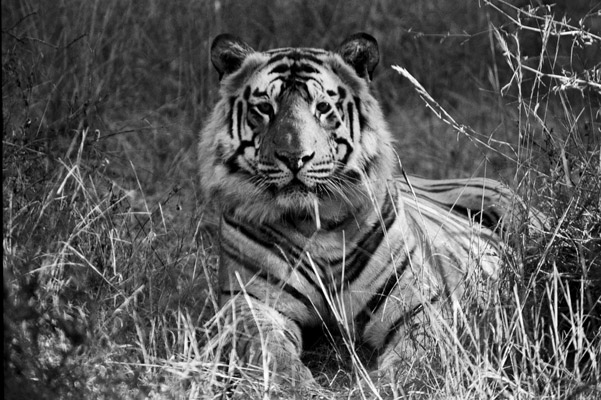
Tiger. Photo by: Cyril Christo and Marie Wilkinson.
The Bushmen have respected the lion as a master hunter. They lived as co- equals. The shape shifting notions arise from an appreciation of the lion’s essence in altered states, which takes a lot of work. As some shamans relate to the stars and the realities beyond this earth, so too they have a relation with the life force of the greatest predator. That takes discipline. It is the exact opposite of the mindless and depraved behavior of trophy hunters who simply kill for its own sake. Even the Maasai who had their fearless warriors take on a lion in the old days, it was a cultural practice about age sets and the young becoming men…it was about bravery. We kill for so-called sport. We are moral cowards and desecrators of life who have no rituals. The Maasai or Bushmen will not kill off the lion. Anemic trophy hunters or Asian interests in passing off lion bones as tiger bones will not help preserve the lion.
The Inuit may have hunted the polar bear but never in excess. The most important belief was never to oppose the vital force (sila) of the world or its species. To kill for some demented notion of fun as the technological society does would be madness to them. There would be some retribution or karmic repercussion. One would have to contend with the polar bear’s soul at some future time. The Inuit say the polar bear is an equal, not a thing or a commodity. Our so-called civilization sees other species as things and the Earth as a commodity. There should be no trade in endangered species. No poaching of any kind. We may be trying to go the stars but we have not had the journeys and visions of those shamans who have.
“In order to survive from the land, you have to protect it. The land is so important for us to survive and live on; that’s why we treat it as part of ourselves.” – Mariano Aupilaarjuk.
The tiger’s future is the future of India’s forests, the future of India and it may be said, a large part of the future of Asia! We in the dominant society see only the manifest, the immediately observable while the native people the world over see below the surface, the larger invisible matrix of reality.
Save the tiger and you save a larger cosmology, the larger ecosystem of humanity. You save those who have inhabited the human psyche since we became a species. That is the educational challenge of our time.
Look at what we are doing to the ice, the rainforests, the oceans and countless organisms. Ours is not only an unviable cosmology, we have no cosmology whatsoever. The life force of the planet is being played out this century. In our film Lysander’s Song, the logo was “What does the future of the elephant have to do with the future of childhood? Everything!” That message has to become one of the cries of our time. The same with lions, and tigers and bears and whales and the entire spectrum of life.
Mongabay: What other artists have inspired your photography?
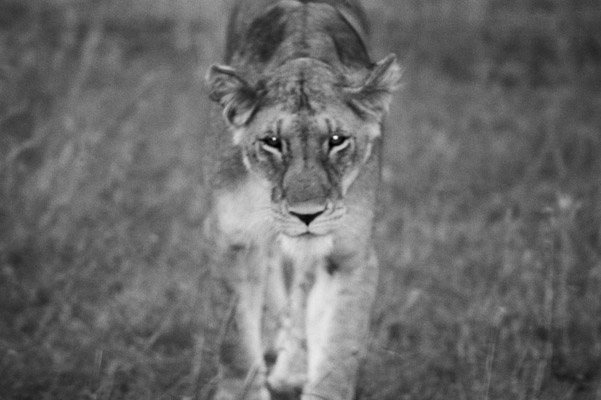
Lioness. Photo by: Cyril Christo and Marie Wilkinson.
Cyril Christo and Marie Wilkinson: Peter Beard’s shots in The End of the Game, especially his charging lion shot is superb. It is dynamic, wonderfully out of focus and reminiscent of the early shots of the XX century but loaded with mystery. His Turkana photos in Eyelids of Morning are timeless because he engaged in the primal not as photographer only but also as an explorer and a poet of the land. He is investigating Africa from the more than merely visually vantage. Therein lies the difference. So many of the photos today are perfect and as Peter has said, boring. They have no soul. There’s no life in them outside the frame. The text by Alistair Graham is the best diatribe on the technological society and its impact on the native mind ever written.
To be captivated by movement is a gift. Paul Caponigro’s Running White Deer in Ireland is a magical frame out of time. The conceit we have established recently is to make animals into fashionable fetishes, exotica rather than singular and irreplaceable events in evolution. Animals are photo shopped and manipulated beyond recognition, as if trying to improve upon them as exotica and not as our peers, which they are!
Mongabay: How did your animal subjects communicate with you while you were photographing them?
Cyril Christo and Marie Wilkinson: Predators do not approach us like elephants and whales. Lions may seem passive compared to tigers but their roaring at dusk and at night is spellbinding. We filmed some lions at night in Botswana and that is when the unworldly presence of their beauty comes alive. One night shot of a lioness in Zambia ten feet from the car was like a primal goddess erupting out of the forest. We missed two black maned lions on the Zambezi River who could have swum from one side to the other side. That would have been phenomenal.

Lions. Photo by: Cyril Christo and Marie Wilkinson.
Tigers are walking incantations and Indians lived quite well with the 40,000 or so that existed over a century ago. They are enigmatic and truly incarnate the Hindu idea of concealment. They hide behind the veil of maya as if to hide from the undeserving eyes of mere humans. But that crouching tigress…her eyes are phantasmagoric like that of the Medusa’s!
Polar bears are curious, like dogs, with which they are very distantly related, but they always remind you that their power is supreme, that they are the most powerful predator on earth. With predator’s eyes, each individual radiates a marvelous, glowing intensity of being and intention.
Mongabay: Which animal behaviors you observed were most surprising?
Cyril Christo and Marie Wilkinson: The tiger climbing the tree in India! The lionesses sitting atop the acacia above the elephant herd in the Serengeti and above all the great Kamunyak lioness in Samburu in 2002 who adopted baby wildebeest antelopes as her own, on several occasions. A wonder to behold!
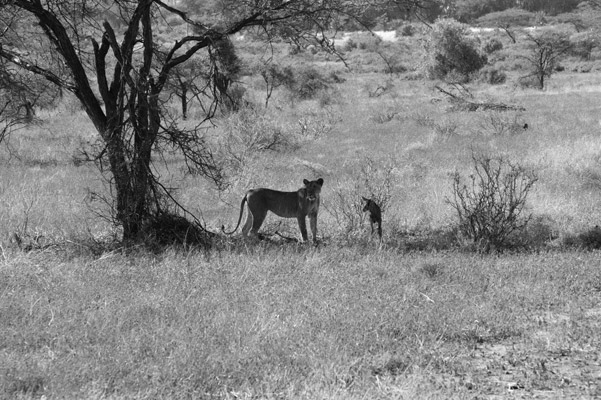
Rare behavior: lioness adopts wildebeest calf. Photo by: Cyril Christo and Marie Wilkinson.
Mongabay: When you meet someone, and you only have 1 minute to describe in words your approach to photographing endangered animals, what do you say?
Cyril Christo and Marie Wilkinson: Don’t be precious or calculating…it’s not about just a perfect photograph, its about the experience of the entire moment. Revel in the moment and if you can, take a shot from the ground and out of the car! The experience is more important than the photograph! But get the photograph or the footage if you can. Be careful and always respectful!
Mongabay: What are you favorite folktales about the lions, tigers, and polar bears you photographed?
Cyril Christo and Marie Wilkinson: Not exactly folktales but stories.
The lion is the Gir forest in India who was startled by pilgrims on their way to a saddhu. The pilgrims walked miles to the hut of the hermit and when they got there, the saddhu asked the pilgrims “How was your encounter with the lion?” How could he have known?
One of the tigers we had seen was so entranced by the saddhu’s at the temple at the gate of the reserve that he regularly came, sat down and listened as if transfixed to his bell when he rang it for his evening prayers!
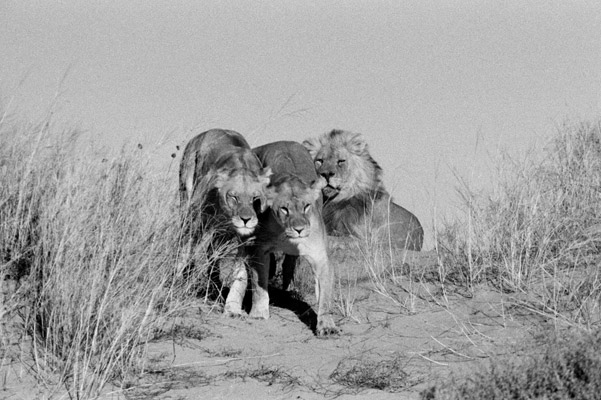
Lions. Photo by: Cyril Christo and Marie Wilkinson.
Mongabay: Can you describe some recent conservation successes and challenges you have observed in the field?
Cyril Christo and Marie Wilkinson: The over sixty percent rise in tiger numbers in Nepal and in Bardia is very encouraging. Thanks to donations by Leonardo Di Caprio of several million dollars for the tiger, and serious conservation measures, the situation is improving. More people with means should do exactly the same all over the world.
Mongabay: What are your saddest stories you have observed regarding conservation of these great animals?
Cyril Christo and Marie Wilkinson: We heard stories in Madya Pradesh of the poaching going on in some of the National parks such as Panna and Ranthambore where tigers were almost annihilated due to the tiger skin trade.
Major flagship parks reduced to almost no tigers. The fact that trophy hunters still kill about 600 polar bears a year for rugs is insane. There are only about 20,000 polar bears on earth. They fact that they have to deal with climate change and rogue humans together is astoundingly sad. The lifeline to their species is at stake. Canadian policies conserving their environment are fantastically out of date and have to be amended. In the Maasai Mara, stories of the decline of the wildlife and the lion over the last decade have been heartbreaking.
Mongabay: What advice do you have teenagers and people in college who want to follow in your footsteps and work supporting the conservation of biodiversity?
Cyril Christo and Marie Wilkinson: The great story of our time is what is happening with the geology of Earth and its species. What the Earth is telling us, do not be afraid of facing it…it is not our interpretation of life, but life that ultimately matters. Seize the day. This is an epochal moment. Go out and do field work. Find that place in the heart that sings the most and collect the stories of those native people who are the ontological immune system of the planet. See what their connection to the wild is and what they still hold fast to. What species need attention? Without them we lose our roots…An electrical engineer in New York saw our film Lysander’s Song in New York and he said the stories we gathered from the native people in East Africa was by far the best way to teach conservation. He said the film was a revelation. People need to support organizations like the TEEB the Economics of Ecosystems and Biodiversity, Save the Tiger, Panthera and all the conservation groups in any way possible.
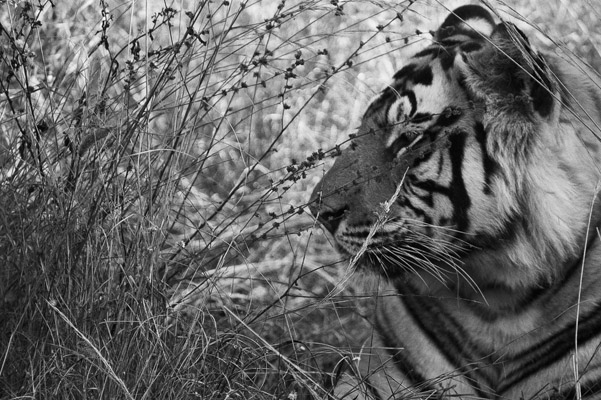
Tiger. Photo by: Cyril Christo and Marie Wilkinson.
The true wealth on earth is its life forms, its forests, not the artificial wealth and perilously fragile and arbitrary system the capitalist system has constructed and in turn, taken away from the planet. Lord Rees, the astronomer in England, calls this our final century. Is it? The media in this country has been woefully derelict of duty reporting on endangered species and climate change. People of all ages have to build connections between their community, the species around them and the larger global community. People have to fight for larger ecosystem of body, mind and spirit because without it we don’t survive. Is this really the last tenable century for civilization? We have created a situation where we are almost completely at odds with the organic world. As if we had launched a war, a WWIII against the planet. Why are we doing this? Just for resources? A hundred years ago we started WWI. A hundred years later the survival of the life force is at stake.
Social, economic, artistic, scientific, religious and political institutions should look long term at what we as humans are about. Why are we here and act accordingly? Ten thousand years ago to a few hundred years ago, the animals and the plant world were part and parcel of our very imagination and spirit. Just look at the medieval bestiaries. They aren’t primitive. They are essential. That basic relationship to the greater than human reality needs to return or it will be imposed upon us from without. We are one planet among tens of billions. The economy and ecology of our civilization need to be seen a one equation. Going into outer space will not solve our problems. Here in the southwest, we have heard elders talking about future changes and the fact that the point of no return, the point at which we need to turn the ship of civilization is 2020. I heard a wonderful Apache, Hopi, Dine elder tell me that one of the future sources of energy was sound. Many people would consider that naïve or romantic but it is not. Last week I saw a video on an experiment from Japan where sound was used for levitation. I have heard stories of computer experts working on climate models go to native elders asking them for advice from their oral traditions. The Hopi have been talking about the coming 5th world and Koyaanisquatsi (world out of balance) for generations but the UN and world leaders have ignored the Hopi teachings and prophecies. I believe much of our future’s knowledge will simply come from the secrets on the ground…like what mushrooms are able to do…what the indigenous tribes of the Amazon, the Congo basin and Indonesia already know. Save the forest elephant from extinction now because in doing so you salvage the second largest rainforest on earth with tremendous climate implications. In other words the digital world can only do so much. Much of the world’s knowledge will come from the dark spots on Earth where there is no electricity. People need to be very curious about other cultures, the ones that go back centuries. Explore and make films and articles and books that don’t just inform but transform us from within. Then you create a lifeline to the past and hopefully the future. Universities need to follow Thomas Berry’s guidelines about the ecological foundation of our society. The next five years are critical.
Mongabay: Which sounds, songs, and videos do you want to share about these animals?
Cyril Christo and Marie Wilkinson: The Last Stand of the African Lion on You Tube and Bringing Back the Tiger also on You Tube. Listen to the lion’s roar and do everything in your power to make sure it is still here generations from now. Let us make sure there are more tigers in 2022, the next year of the tiger, than today. Look at the evidence of the iceberg retreat. Let us finally get a climate policy for civilization. The Arctic fauna are suffering, not just the polar bear. The future of much of life is being played out this decade.
Mongabay: How do you empower yourselves to never give up in working to achieve the conservation of lions, tigers, and polar bears? How do you feel photographing lions, tigers, and polar bears knowing they may go extinct in our lifetimes?

Polar bear. Photo by: Cyril Christo and Marie Wilkinson.
Cyril Christo and Marie Wilkinson: Paul Shepard once wrote “We will save them, if at all, because without them, we are lost.” People are starting to awaken to the fact that their own place in the world is at stake e.g. the tigers of Bardia and Nepal. If we do not succeed, why indeed have children? What will they have to look forward to? The species are still there. To see a live, awesome being (all beings are singular and remarkable) is to connect and to celebrate the essence of life. To take an inspiring image or film is worth much more than a listless trophy hanging on the mantelpiece. Go hear the wolves. They were so close to extinction in the lower 48 states. Hear their song and you are changed forever. Their song it part of who you are. They inhabit you. Then your life will be changed forever. While tigers still move on earth, save up and go and witness them. A billion Indians and many other Asians and the world community will hear your story and be appropriately moved. But tell your story in a way that has force and that has not been told before. There is not a child on earth that does not want to see a tiger. They have to be told that their spirit still moves on this earth. Then a bridge is made that may literally move them world. When several Indians jumped from their car onto ours just to get a glimpse of a tiger, it was like they wanted to see an aspect of Brahma. They had come hundreds of miles, while we had come from ten thousand miles away to get a glimpse of a near deity. That, more than any human invention or art, is what makes life worthwhile. It is not our interpretation of life that matters but the life force itself. To hear a lion roaring in the distance in Africa is equivalent to hearing the cosmos talk back to you. For our sake, and especially for theirs, let’s hold onto them. Nature can do without us, but we simply cannot do without nature.
It is the message of the 21st Century.
Mongabay: What is the one thing the government, communities, businesses, religious institutions, and individuals can do to protect lions, tigers, and polar bears?
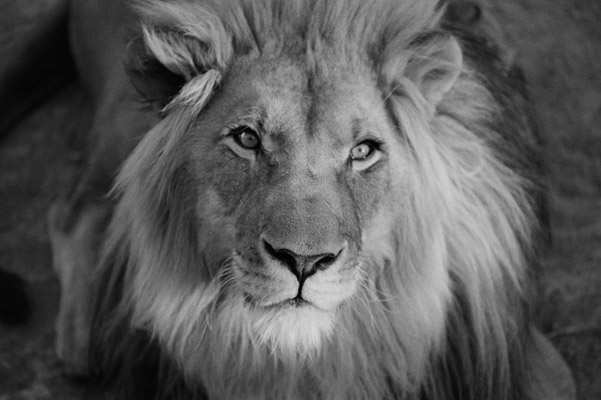
Male lion. Photo by: Cyril Christo and Marie Wilkinson.
Cyril Christo and Marie Wilkinson: Major education and publicity campaigns and funding to support the critical importance of the environment, the rainforests, the oceans, tribal groups around the world and endangered species. The Canadian government needs to promote the protection of the polar bear and to disallow polar bear hunting now. It is an endangered species. The Indian government and the governments of Asia need to act as if the tiger were as important as the Taj Mahal and crack down on corruption at all levels. Hunting for lions in Africa needs to be banned everywhere as Botswana has recently done. The Chinese government needs to crack down on the illegal wildlife trade once and for all and become a force for conservation! Here in the United States, the campaign to save a major predator, the wolf is necessary for the future of the species. My wife, Marie, and I saw our first wolves in Yellowstone before Lysander was born. The primal relationship to the other is in our blood and our conscience even before birth. What are we saying to children all over the world if we become the only predator? The question is, do we care enough about our own children to save what is left of the planet?
The message of someone like the Green Patriarch, Patriarch Bartholomew, speaks to the crisis of the planet that transcends religious and political boundaries. Humans were meant to honor the world and be stewards of existence. Witness the caves of Lascaux. We as a species were meant to walk in tandem with the life force. The Guardian paper published a piece “Animal Extinction is the Greatest Threat to Humanity.” Or as Jean Malaurie wrote in his exquisite The Last Kings of Thule (1956) “The Earth is living: it can and will avenge itself: already there are portents. The Earth has not time left for man’s ignorance, arrogance, sophistry and madness.” It is time.
Mongabay: What are one saying from Indigenous Peoples regarding each—lions, tigers, and polar bears—that you want to leave us to think deeply?
Cyril Christo and Marie Wilkinson: “Everything is spirit. This is the essential thing for you to remember. The forces are our friends, our relatives,” an Inuit elder to Jean Malaurie as he recounted in his book The Last Kings of Thule (1956).
“The lion and I are brothers,” a Gwi Bushmen told Survival International, from the Central Kalahari Game Reserve in Botswana. “I am confused that I should have to leave this place but the lion can stay.”
“I think that they have some sixth sense, to find out who is the protector of the forest and who is the destroyer. A careful, watchful, respectful person is never killed by the tiger in Sunderbans,” Kalyan Chakrabarti in The Spell of the Tiger by Sy Montgomery.
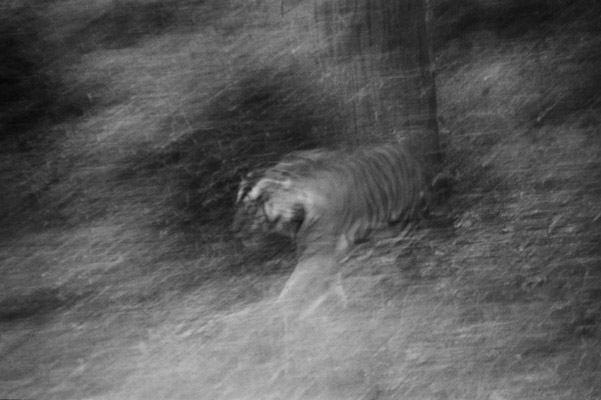
Tiger. Photo by: Cyril Christo and Marie Wilkinson.

Polar bear. Photo by: Cyril Christo and Marie Wilkinson.

Lion. Photo by: Cyril Christo and Marie Wilkinson.
Biographies: Cyril Christo and Marie Wilkinson have been working together as a husband and wife team since 1997, when they first began investigating and documenting the relationship between the indigenous human and natural world on five continents. Their first book of photography in black and white, Lost Africa: The Eyes of Origin (Assouline 2004), explores the ecological and man-made challenges facing tribes from Ethiopia to Namibia, which also placed in the fine art book category at the International Photography Awards in 2008. Their book, Walking Thunder: In the Footsteps of the African Elephant, is one of the first manifestos in black and white ever dedicated to a single species in the wild. It placed in the Nature book category at the International Photography Awards in 2010. A documentary dedicated to the elephant The Last Stand of the African Elephant narrated by Ali McGraw in available on You Tube. They are working on a feature documentary with their son Lysander called Walking Thunder: The Last Stand of the African Elephant. Cyril Christo is a poet, whose film A Stitch for Time—an anti-nuclear documentary— was nominated for an Academy Award in 1988. Marie Wilkinson is an architect, planner, and photographer.
How to order:
Hardcover: In Predatory Light: Lions and Tigers and Polar Bears
Publisher: Merrell
Author: Elizabeth Marshall Thomas, Sy Montgomery, and John Houston, authors; Cyril Christo and Marie Wilkinson, photographers
ISBN: 9781858946108
Gabriel Thoumi is a contributor to Mongabay
Related articles
Over 75 percent of large predators declining
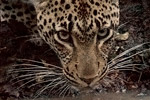
(01/09/2014) The world’s top carnivores are in big trouble: this is the take-away message from a new review paper published today in Science. Looking at 31 large-bodied carnivore species (i.e those over 15 kilograms or 33 pounds), the researchers found that 77 percent are in decline and more than half have seen their historical ranges decline by over 50 percent. In fact, the major study comes just days after new research found that the genetically-unique West African lion is down to just 250 breeding adults.
Lions face extinction in West Africa: less than 250 survive
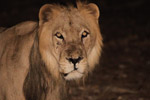
(01/08/2014) The lions of West Africa, which may represent a distinct subspecies, are on the precipice of extinction. A sober new study in PLOS ONE reports that less than 250 mature lions survive in the region. Scientists have long known that West Africa’s lions were in trouble, but no one expected the situation to be as dire as it was. In fact, in 2012 scientists estimated the population at over 500. But looking at 21 parks, scientists were shocked to find lions persisted in just four with only one population containing more than 50 individuals.
Samburu’s lions: how the big cats could make a comeback in Kenya
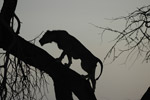
(09/30/2013) In 2009 conservationists estimated that less than 2,000 lions survive in Kenya, a drop of 26 percent in just seven years. In addition, the East Africa country continues to hemorrhage lions: around a hundred a year. Poaching, poisoning, and large-scale habitat loss has put lions on the defensive across Africa, but even countries once thought lion strongholds–like Kenya–have seen populations harried to devastation and in some cases local extinction. Shivani Bhalla, a fourth-generation Kenyan, is working to turnaround this trend in Samburu National Reserve.
Lions rising: community conservation making a difference for Africa’s kings in Mozambique
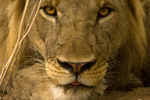
(09/17/2013) Everyone knows that tigers, pandas, and blue whales are threatened with extinction—but lions!? Researchers were shocked to recently discover that lion populations have fallen precipitously: down to around 30,000 animals across the African continent. While 30,000 may sound like a lot, this is a nearly 70 percent decline since 1960. In addition, lion populations are increasingly fragmented with a number of populations having vanished altogether. However, there is hope: one place where lion populations are actually on the rise is Niassa National Reserve in Mozambique. Here, lion populations have risen by around 60 percent in just seven years. In part this is due to the effort of Colleen and Keith Begg.
Protecting predators in the wildest landscape you’ve never heard of
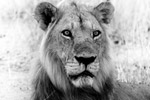
(09/10/2013) The Serengeti, the Congo, the Okavango Delta: many of Africa’s great wildernesses are household names, however on a continent that never fails to surprise remain vast wild lands practically unknown to the global public. One of these is the Ruaha landscape: covering 51,800 square kilometers (20,000 square miles) of southern Tanzania’s woodlands and savannah, Ruaha contains the largest population of elephants in East Africa, over 500 bird species, and a wealth of iconic top predators, including cheetah, hyena, wild dogs, leopard, and—the jewel in its crown—10 percent of the world’s lions. But that’s not all, one of Africa’s least-known and secretive tribal groups, the Barabaig, also calls Ruaha home.
Featured video: how tigers could save human civilization
(08/29/2013) In the video below, John Vaillant, author of the The Tiger: A True Story of Vengeance and Survival, tells an audience at TEDxYYC about the similarities between tigers and human beings. Given these similarities—big mammals, apex predator, highly adaptable, intelligent, and stunningly ‘superior’—John Vaillant asks an illuminating question: what can we learn from the tiger? It turns out learning from tigers could help conserve the human race.
(07/30/2013) Nearly two hundred tigers roam the lowland forests of Nepal, according to a new survey. This is a 63 percent increase in the country’s tiger population since 2009, and rare good news for global efforts to save the tiger from extinction.
Just how far can a polar bear swim?
(05/03/2012) Polar bears (Ursus maritimus) are capable of swimming incredible distances, according to a new study published in Zoology, which recorded polar bears regularly swimming over 30 miles (48 kilometers) and, in one case, as far as 220 miles (354 kilometers). The researchers believe the ability of polar bears to tackle such long-distance swims may help them survive as seasonal sea ice vanishes due to climate change.
Mass walrus haul-outs, polar bear cub mortality linked to climate change

(09/01/2011) Recent, unprecedented walrus haul-outs and increased instances of long-distance swims by polar bears show the direct impacts on wildlife of dwindling Arctic sea ice from climate change. These threatened species also face the prospect of offshore drilling in the Arctic after the Obama Administration recently approved a number of plans to move forward on oil exploration. At least 8,000 walruses hauled out on an Alaskan beach along the Chukchi Sea on August 17. Only a day before, the U.S. Geological Survey announced it would begin tagging walruses near Point Lay, Alaska to study how a lack of sea ice is affecting the species.
The truth about polar bears and climate change

(06/21/2011) Although scientists say innumerable species are threatened by climate change, polar bears have been the global symbol of the movement to rein-in greenhouse gas emissions. This is perhaps not surprising, since polar bears are well known to the public—even though they inhabit a region largely absent of humans—and they make a big impression. Their glaringly white coat contrasts with their deadly skills: as the world’s biggest terrestrial predators, they are capable of killing a seal with single blow. When young they are ridiculously adorable, but when adults they are stunning behemoths. But that’s not all. Unlike many other species, the perils of climate change are also easy to visualize in connection with polar bears: their habitat is literally melting away.
Disappearance of arctic ice could create ‘grolar bears’, narlugas; trigger biodiversity loss
(12/22/2010) The melting of the Artic Ocean may result in a loss of marine mammal biodiversity, reports a new study published in the journal BNature and conducted jointly by the National Oceanic and Atmospheric Association (NOAA), the University of Alaska, and the University of Massachusetts. The study is the first to project what might happen if species pushed into new habitats because of ice loss hybridize with one another, resulting in such crossbreeds as “narlugas” and “grolar bears”.